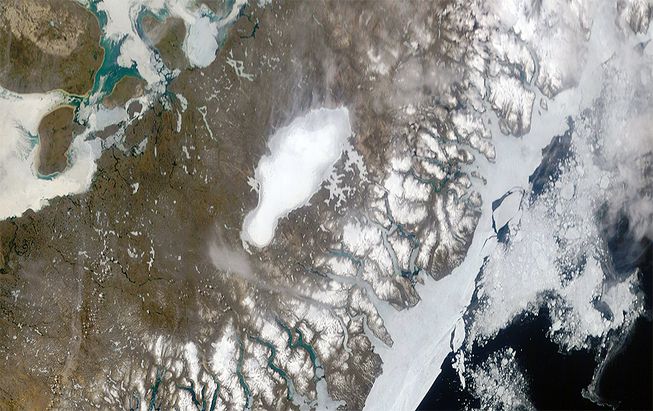A remnant of the force that carved the Great Lakes will soon vanish
Some 20,000 years ago, the sites now known as New York City, Chicago and St. Louis were covered by massive glaciers up to a mile thick and extending seemingly unbroken across the northern horizon. Called the Laurentide Ice Sheet, this giant of the last Ice Age scoured millions of square miles of North America and, after retreating 14,000 years ago, left behind a reshaped world that included the Great Lakes, Niagara Falls and even Long Island.
Today, a last surviving remnant of the Laurentide Ice Sheet can still be found on Baffin Island in the Canadian Arctic. Called the Barnes Ice Cap, researchers estimate it separated from the Laurentide 8,500 years ago and retreated to an area roughly the size of Delaware. For several millennia it remained stable, part of the normal wax and wane consistent with interglacial history. Over the last century, however, the rate of retreat in response to a dramatically warming Arctic climate has increased. It shows no signs of abating.
“The geological data is pretty clear that the Barnes Ice Cap almost never disappears in the interglacial times,” Giffford Miller, a professor at the University of Colorado Boulder and co-author of a 2017 paper on the ice cap’s retreat, said in a statement. “The fact that it’s disappearing now says we’re really outside of what we’ve experienced in 2.5-million-year interval. We are entering a new climate state.”
Gifford and a team of researchers from the University of Colorado’s Institute of Arctic and Alpine Research (INSTAAR), made headlines earlier this year after they discovered that Baffin Island is likely experiencing its warmest century in the past 115,000 years. By their estimates, the Barnes Ice Cap has perhaps only two to three centuries left before it vanishes.
“I think the disappearance of the Barnes Ice Cap would be just a scientific curiosity if it were not so unusual,” said Miller. “One implication derived from our results is that significant parts of the southern Greenland Ice Sheet also may be at risk of melting as the Arctic continues to warm.”
A post-glacial dip for U.S. cities
 As glacial ice thins in Canada and land rises, some parts of Chicago and other U.S. cities are sinking. (Photo: Ben Sutherland/Flickr)
As glacial ice thins in Canada and land rises, some parts of Chicago and other U.S. cities are sinking. (Photo: Ben Sutherland/Flickr)
As ice sheets in the Arctic retreat and expose land in some locations that have not seen sunlight in at least 40,000 years, a bizarre phenomenon is unfolding deep within the Earth’s crust that ‘ causing some cities in the U.S. to sink. Called isostatic adjustment, this post-glacial effect slowly occurs over the course of thousands of years as heavy sheets of ice diminish and allow the crushed earth below to rebound. It’s estimated that after its 2,000-foot-thick glacier retreated, the land below New York City rose by more than 150 feet.
For some U.S. cities, such as Chicago, the rise was temporary. In fact, as Canada has lost more of its ice cover over time and the land there has slowly begun to rebound, the Windy City is starting to sink. Over the last century, the land supporting the urban core has decreased by four inches and, by some estimates, will continue to sink at a rate of one or 2 millimeters a year.
“Over a decade that’s a centimeter. Over 50 years, now, you’re talking several inches,” Daniel Roman, chief geodesist at NOAA, tells Tony Briscoe at the Chicago Tribune. “It’s a slow process, but it’s a persistent one.”
This see-saw of the Earth’s crust will cause the Great Lakes to undergo some changes, with the northern ends becoming shallower as the Earth’s crust rises and the southern portions growing deeper as it sinks. This could mean larger storm surges and flooding for cities like Chicago in the future.
“If you’re tilting one direction, the water flows might change direction or water might accumulate in a way different than you expected in the past,” NOAA’s Roman told the Tribune. “That’s important for on-land and near-shore environments. You might get more water, but not where you want it.”
Chicago isn’t alone in experiencing the after-effects of the last Ice Age. Washington, D.C., already concerned with sea level rise, is expected to sink by as much as six inches by 2100.

